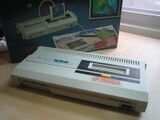Difference between revisions of "Main Page"
From Sega Retro
Scarred Sun (talk | contribs) |
Scarred Sun (talk | contribs) |
||
| Line 6: | Line 6: | ||
<td class="involved" style="width:46%; margin-right:2px;"> | <td class="involved" style="width:46%; margin-right:2px;"> | ||
===Featured Article=== | ===Featured Article=== | ||
| − | [[File: | + | [[File:Aaronix.jpg|right|160px]]A '''clone console''' or '''console clone''', is usually an unlicensed reproduction of an officially branded video game console. They usually exist to fund the pirate trade in an attempt to gain money off the works of other companies. |
| − | '''[[ | + | Clone consoles exist because popular video game manufacturers such as Sega or Nintendo were often slow to market their products in every region of the world. Traditionally a video game console is released in Japan first, then brought to North America, then to PAL regions such as Europe and Australia. But the world is much bigger than these regions, and it often takes months if not years for products to make it to smaller markets such as South America, Asia and Africa. Often the big companies decide against marketing their products in these places as they do not feel they can make a big enough return, or because piracy or various laws prevent them from doing so. |
| + | |||
| + | '''[[Clone console|Read full article]]'''... | ||
</td> | </td> | ||
<td class="news" style="width:46%; margin-left: 2px;"> | <td class="news" style="width:46%; margin-left: 2px;"> | ||
Revision as of 12:51, 26 July 2010
Welcome to Sega Retro, a new project from the people behind Sonic Retro. We aim to cover everything possible about Sega from the 1940s to today. We currently are working on 43,639 articles and have many more that are requested to be worked on.
While this wiki is designed to help the community by providing information, it is also dependent on the community to be updated. Anyone with an account may edit the wiki. As you feel more comfortable with the site, please feel free to make any changes or additions that you feel necessary.
Featured ArticleA clone console or console clone, is usually an unlicensed reproduction of an officially branded video game console. They usually exist to fund the pirate trade in an attempt to gain money off the works of other companies.Clone consoles exist because popular video game manufacturers such as Sega or Nintendo were often slow to market their products in every region of the world. Traditionally a video game console is released in Japan first, then brought to North America, then to PAL regions such as Europe and Australia. But the world is much bigger than these regions, and it often takes months if not years for products to make it to smaller markets such as South America, Asia and Africa. Often the big companies decide against marketing their products in these places as they do not feel they can make a big enough return, or because piracy or various laws prevent them from doing so. |
Forum Updates<rss>http://forums.sonicretro.org/index.php?act=rssout&id=2%7Ccharset=UTF-8%7Cshort%7Cdate%7Cmax=12</rss> |
Get Involved!
You can become a part of the Sega Retro community in several different ways:
- Sign up for a Sega Retro account and become part of our group of editors (If you have a Sonic Retro account please use the same username for your account here)
- Log on to BadnikNET (irc://irc.badnik.net) and join #sega, our dedicated IRC channel
- Speak another language? Help us by translating texts from Japanese.
Affiliates: SEGABits | SEGA Memories
Dreamcast Junkyard | Nomad Junkyard
Saturn Junkyard | SegaShiro
